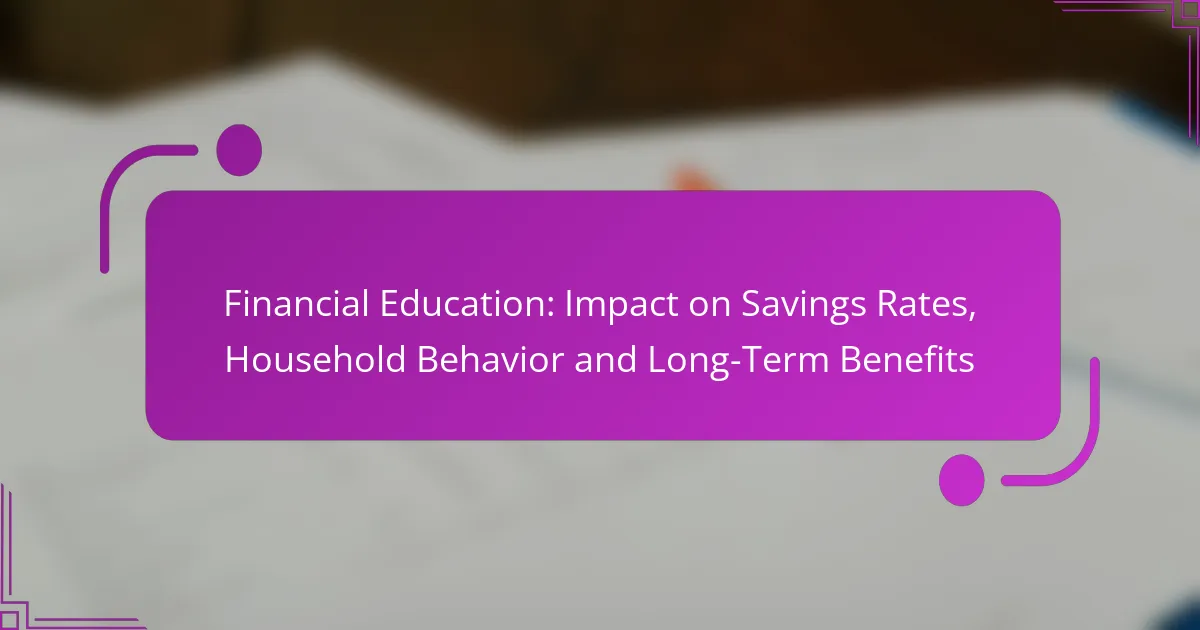Financial education plays a crucial role in enhancing savings rates and improving household financial behavior. By equipping individuals with essential knowledge and skills, it enables better decision-making related to budgeting, investments, and debt management. As a result, individuals experience increased financial stability and long-term benefits, including wealth accumulation and reduced financial stress.

How does financial education impact savings rates in the United States?
Financial education significantly enhances savings rates in the United States by equipping individuals with the knowledge and skills to manage their finances effectively. This education fosters better decision-making regarding savings, investments, and budgeting, ultimately leading to increased financial stability.
Increased savings rates
Individuals who receive financial education are more likely to save consistently and increase their savings over time. Studies suggest that those with financial literacy can save anywhere from 5% to 20% more of their income compared to those without such knowledge. This increase often stems from understanding the importance of emergency funds and retirement savings.
For example, a person educated in finance may prioritize setting aside a portion of their paycheck into a savings account or retirement fund, rather than spending it impulsively. This proactive approach can lead to substantial long-term benefits.
Improved financial literacy
Financial education enhances overall financial literacy, which is crucial for making informed decisions. Individuals become familiar with concepts such as interest rates, inflation, and investment options, enabling them to navigate financial products more effectively. Improved literacy often translates to better management of debt and more strategic saving practices.
For instance, understanding compound interest can motivate individuals to invest early, as they recognize the potential for their savings to grow significantly over time. This knowledge empowers them to make choices that align with their financial goals.
Behavioral changes in spending
Financial education can lead to significant behavioral changes in spending habits. Individuals who understand their financial situation are more likely to create and adhere to budgets, reducing unnecessary expenditures. This shift in behavior often results in increased savings and a more secure financial future.
Moreover, educated consumers tend to avoid high-interest debt, such as credit card debt, by making informed choices about their purchases. They may adopt strategies like the 50/30/20 rule, allocating 50% of their income to needs, 30% to wants, and 20% to savings, which promotes a balanced financial approach.

What are the long-term benefits of financial education?
Financial education provides individuals with the knowledge and skills necessary to make informed decisions about their finances, leading to significant long-term benefits. These advantages include increased wealth accumulation, improved investment choices, and reduced financial stress.
Higher wealth accumulation
Financial education equips individuals with strategies to save and invest effectively, contributing to higher wealth accumulation over time. By understanding concepts like compound interest and the importance of starting early, individuals can significantly grow their savings.
For example, a person who begins saving at a young age, even small amounts, can accumulate tens of thousands of dollars by retirement due to compounding. Setting clear savings goals and regularly contributing to retirement accounts can further enhance this growth.
Better investment decisions
With a solid foundation in financial education, individuals are more likely to make informed investment decisions. They learn to evaluate risks and returns, diversify their portfolios, and understand market trends, which can lead to more successful investment outcomes.
For instance, a well-educated investor may choose a mix of stocks, bonds, and mutual funds that align with their risk tolerance and financial goals, rather than relying on tips or trends. This strategic approach can yield better long-term returns and minimize losses.
Reduced financial stress
Financial education can significantly reduce financial stress by providing individuals with the tools to manage their finances effectively. Understanding budgeting, debt management, and emergency savings can lead to greater financial stability and peace of mind.
For example, individuals who create and stick to a budget are less likely to experience financial crises, as they can anticipate and prepare for expenses. Additionally, having a solid emergency fund can alleviate the anxiety associated with unexpected financial challenges.

How does financial education influence household behavior?
Financial education significantly impacts household behavior by equipping individuals with the knowledge and skills necessary to manage their finances effectively. This education fosters better decision-making regarding budgeting, savings, and debt management, ultimately leading to improved financial stability.
Enhanced budgeting skills
Financial education enhances budgeting skills by teaching individuals how to track income and expenses effectively. This knowledge allows households to create realistic budgets that align with their financial goals, leading to better spending habits.
For example, individuals learn to categorize expenses into needs and wants, helping them prioritize essential spending. A practical approach is the 50/30/20 rule, where 50% of income goes to needs, 30% to wants, and 20% to savings and debt repayment.
Increased emergency savings
With financial education, households are more likely to prioritize building emergency savings. Understanding the importance of having a financial cushion encourages individuals to set aside funds for unexpected expenses, reducing reliance on credit.
A common recommendation is to save three to six months’ worth of living expenses. This can be achieved through automatic transfers to a savings account, making it easier to build savings without the temptation to spend.
Improved debt management
Financial education leads to improved debt management by providing individuals with strategies to handle existing debts and avoid accumulating new ones. Knowledge about interest rates, repayment plans, and credit scores empowers households to make informed decisions.
For instance, individuals can learn to prioritize high-interest debts first or consider debt consolidation options. Understanding the implications of late payments can also motivate timely repayments, ultimately enhancing creditworthiness and financial health.

What programs are effective in delivering financial education?
Effective financial education programs include community workshops, online courses, and school-based initiatives. These programs aim to enhance financial literacy, improve savings rates, and influence positive household behaviors.
Community workshops
Community workshops provide hands-on learning experiences that can engage participants directly. They often cover topics such as budgeting, saving, and investing, and may include interactive activities to reinforce concepts.
These workshops can be organized by local nonprofits, banks, or government agencies and typically cater to specific demographics, such as low-income families or young adults. Participants benefit from real-time feedback and the opportunity to ask questions in a supportive environment.
Online courses
Online courses offer flexibility and accessibility for individuals seeking financial education. Many platforms provide a range of topics, from basic budgeting to advanced investment strategies, allowing learners to progress at their own pace.
These courses can be free or low-cost, making them an attractive option for those with limited resources. Look for courses that include interactive elements, such as quizzes or discussion forums, to enhance engagement and retention of information.
School-based programs
School-based financial education programs aim to instill financial literacy in students from a young age. These programs often integrate financial concepts into existing curricula, teaching students about saving, spending, and responsible financial decision-making.
Effective school programs typically involve practical activities, such as simulations or projects, to help students apply what they learn. Collaboration with local financial institutions can also enhance these programs by providing resources and real-world insights.

What criteria should be used to evaluate financial education programs?
To evaluate financial education programs effectively, consider criteria such as participant engagement, content relevance, and measurable outcomes. These factors help determine the program’s effectiveness in improving financial literacy and influencing positive financial behaviors.
Participant engagement
Participant engagement is crucial for the success of financial education programs. Programs that actively involve participants through interactive sessions, discussions, and practical exercises tend to yield better results. Engaged learners are more likely to absorb information and apply it to their financial decisions.
To enhance engagement, consider using real-life scenarios and case studies that resonate with the audience. For example, incorporating local financial challenges or success stories can make the content more relatable and encourage participation.
Content relevance
Content relevance ensures that the material presented in financial education programs aligns with the participants’ needs and circumstances. Programs should focus on topics such as budgeting, saving, investing, and debt management, tailored to the demographic and economic context of the audience.
For instance, a program aimed at young adults might emphasize student loans and credit card management, while one for retirees could focus on retirement savings and estate planning. Regularly updating the curriculum to reflect current financial trends and regulations is also essential.
Measurable outcomes
Measurable outcomes are vital for assessing the effectiveness of financial education programs. Establish clear metrics to evaluate changes in participants’ financial behaviors, such as increased savings rates or improved budgeting practices. Surveys and assessments before and after the program can provide valuable insights.
Consider using a combination of quantitative and qualitative measures. For example, tracking the percentage of participants who create a budget after the program can be complemented by testimonials about their experiences and confidence in managing finances. This dual approach offers a comprehensive view of the program’s impact.

How can financial education be tailored for different demographics?
Financial education can be customized to meet the unique needs of various demographics by considering their specific financial situations, knowledge levels, and goals. Tailoring programs ensures that individuals receive relevant information and skills that can lead to improved financial behaviors and outcomes.
Programs for low-income families
Financial education programs for low-income families often focus on budgeting, saving, and accessing financial resources. These programs may include workshops that teach participants how to manage limited income effectively and prioritize essential expenses.
Examples of effective strategies include teaching families to create a simple budget that allocates funds for necessities and savings. Additionally, programs may provide information on government assistance programs, community resources, and low-cost banking options to help families improve their financial stability.
Workshops for young adults
Workshops aimed at young adults typically cover topics such as student loans, credit management, and investing basics. These sessions are designed to equip young individuals with the knowledge to make informed financial decisions as they transition into independence.
For instance, workshops may include practical exercises on how to read a credit report or create a savings plan for future goals, like buying a home. Engaging young adults through interactive activities can enhance their understanding and retention of financial concepts.
Resources for retirees
Financial education resources for retirees focus on managing retirement savings, understanding pensions, and planning for healthcare costs. As individuals approach retirement, it is crucial to understand how to stretch savings and make informed decisions about withdrawals.
Retirement planning seminars often provide insights into Social Security benefits, investment strategies for a fixed income, and estate planning. Tools like retirement calculators can help retirees estimate their financial needs and adjust their spending accordingly to maintain their desired lifestyle.


